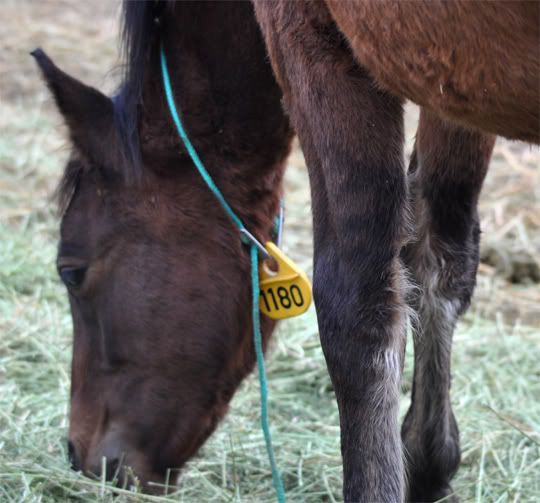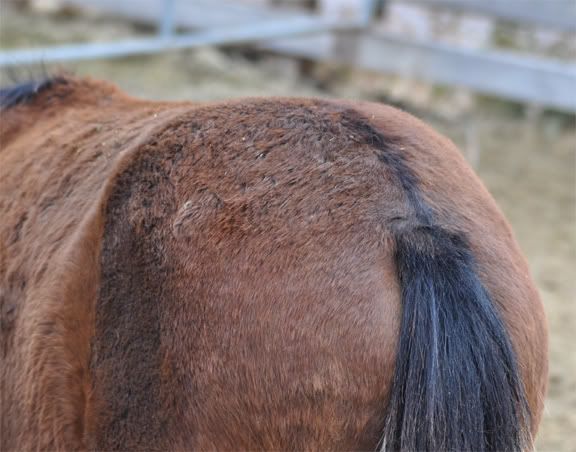|
|
Post by gotkiger on Oct 5, 2011 15:40:32 GMT -5
Ok so i have been putting of turning in Frodos registration paperwork because I have been debating weather he is a dun or a bay. He still has his dorsal stripe fawn on the inside of his ears black points and just now I swear I saw leg bars on his front right leg. Does anyone have any pictures of a horse that appears to be bay until you look a little closer and can see the other markings? I will get pictures over the next few days, it's raining today on and off so when it dries up a little and I have better light I will get out there and get some pictures. Thanks
|
|
|
|
Post by barbhorses on Oct 5, 2011 15:59:08 GMT -5
I always thought that he was a bay...
|
|
|
|
Post by gotkiger on Oct 5, 2011 18:26:52 GMT -5
I thought the dorsal would go away and he would just be a nice bright bay. I havent climbed up on a fence to take a new picture of his back (yes he is so tall that i have to climb on a fenc to see the top of him clearly) but from what I can see from the ground the dorsal is still there, the fawn innner ear is still there and i could have sworn I saw leg bars showing up on his upper leg where the foal coat is still revealing the black socks of the"bay" coat. Dollie is a zebra dun covered up by gray. I have pictures of her as a youngster and she had a very sooty face, very dark legs and almost no bi-coloring of her tail. What i am curious about is this. With both parents being homozigus black with one agouti (which could be brown instead) and he himself being homozigus black with one agouti. IF he is a dun instead of bay and has the sooty gene as well could the fact that both parents are homozigus black play a role in a dun being so dark that they look bay or could this be more of the agouti being brown instead of bay?
|
|
|
|
Post by gotkiger on Oct 5, 2011 23:31:54 GMT -5
They aren't the best but it is what I could get with him trying to eat my ponytail and run around and play after the rain Front Left  Front Right  Dorsal  Neck and profile  |
|
|
|
Post by barbhorses on Oct 6, 2011 0:18:30 GMT -5
That looks like counter shading. Stripes on the legs and dorsal stripes are crisp and defined. His dorsal stripe has faded edges and appears to not even continue all the way to his wither. His leg "stripes" are also not defined at all. Dr. Sponenberg would know more about this, but usually when a bay has a solid dorsal stripe it is referred to as a line backed bay (not a dun). My own conclusion is that Frodo (love the name btw! HUGE LOTR fan and Frodo is Celtic (I believe) for wisdom.  ) is a bay with counter shading. |
|
|
|
Post by fantasykiger on Oct 6, 2011 10:12:50 GMT -5
hard to say but you can have him tested for the dun gene, all I know is he is growing up super cute.
|
|
|
|
Post by gotkiger on Oct 6, 2011 10:49:28 GMT -5
lol yeah my husband named him that. I was tossing a few things around in my mind for his registered name and came up with DD's Afortunado, i figured his barn name would come with time when his personality came through. The night he was born I was kneeling in the corral next to him and Dollie was off getting a bite to eat. I looked up at my husband and said "DD's Afortunado, that is what I will call him" And his responce was "Frodo it is". Got to love it. I find it a little ironic Frodo in LOTR was short and had hairy feet. My Frodo is by no means short and has very non-hairy feet (the joke about that is I almost bred Dollie to a fresian so there would have been some hair)
Thanks I hope to get better pictures when he calms down a little more and i have more time. I weaned him on sunday and sent Dollie to a friends house for a month or so. He hasnt ben too crazy but he still look for her and calls for her when i turn him out.
|
|
|
|
Post by kimk on Oct 7, 2011 0:59:31 GMT -5
Kimberlee. REALLY? It does NOT look like countershading! Looks to me like you've got a dark dun, gotkiger!!
|
|
|
|
Post by gotkiger on Oct 7, 2011 11:49:39 GMT -5
i like the way you thin Kim, lol. My mother is convinced he is abay just because of the shade of his coat. His paperwork was sent is saying bay but they dont charge to change the color so i can do that next year when we know for sure.
|
|
|
|
Post by barbhorses on Oct 7, 2011 13:12:30 GMT -5
His dorsal "stripe" isn't clear and doesn't continue to his wither. That is counter shading. He is a bay with counter shading and not a dun.
UC Davis' explanation on what dun is: "Dun is a dominant gene that dilutes the color of body hair, leaving the points and head unaffected. Dun horses also show "primitive markings" consisting of a dark dorsal stripe, leg barring, shoulder stripes and concentric marks on the forehead (spiderwebbing, cobwebbing). The dorsal stripe appears to be a consistent feature of dun horses while the other "primitive marks" vary and may not all be present, or visible."
What is also interesting is that the Ravenseyrie Sorraia Mustang project had their "dark grullas" and other grullas color tested using the dun zygosity test and the darker "grullas" didn't have the genetics they look for in a dun horse and the grullas (can see stripes) tested positive.
I think that there is something else going on here as far as horses that are black or bay and being called dun just because of buff hair in the ears. I also think that Kiger people are far too quick to call a bay or black horse a dun due to the prejudice the founders of the breed have/had against non-dun horses ignorantly believing that dun = Spanish and passing that ignorance on to newcomers to the breed. A non-striped Kiger is no less a Kiger than its dun counterparts.
|
|
|
|
Post by Michelle Clarke on Oct 8, 2011 0:53:31 GMT -5
Yeah, really? Dark dun...did you ever think of a dark dun having sooty also, so that creates "countershading" and that could be added on top of the dorsal and leg bars? Dun is really not defined yet because there is no true test. Due to the fact it is believed to be a cluster of genes, then it is very possible that only parts can be apparent. Also, it is not known how they pair up with other color genes. For example, the pearl gene combined with the creme creates a pseudo double dilute. Someones opinion on what a dun is may change when more information is available. What color would you say this little guy is? www.blm.gov/adoptahorse/horse.php?horse_id=4612 |
|
|
|
Post by barbhorses on Oct 8, 2011 1:37:57 GMT -5
Well, you really cannot see if he has a stripe on his back. He looks like he will shed out to be a slightly light bay.
On Kigers, I feel that people are too quick to say a horse is dun due to prejudice against non-dun horses. Frodo doesn't have a clear and defined dorsal and it doesn't even continue to his wither. That is NOT a dorsal stripe. That is counter shading. A true dorsal has crisp outer edges and is always a solid line. Not being dark at the croup and lightening up and disappearing to the wither (such is the case with Frodo).
Frodo is a lovely bay colt with counter shading.
|
|
|
|
Post by Michelle Clarke on Oct 8, 2011 7:42:13 GMT -5
Bullcrap with the clear dorsal not being a real dorsal if it does not go to the withers. Yes, that is desirable, but not a defining qualification if a horse is dun or not. I have plenty of dun, grulla and red duns that are clearly dun factor and the dorsal that does not go to the wither crystal clear. Here is that colts' legs:  Dorsal:  |
|
|
|
Post by kimk on Oct 8, 2011 9:20:21 GMT -5
bullhunky Kimberlee. He DOES have a clear defined dorsal and also happens to have countershading with it which is a desirable trait. I think you need to see the optometrist. Or perhaps someday when you grow up you will realise you do not know it all. It would be nice if you took all of your infinite wisdom back to the sulphur folks and stopped coming on here slamming Kigers and kiger folks.
|
|
|
|
Post by barbhorses on Oct 8, 2011 11:52:53 GMT -5
Kim - I was defending Kigers that don't have stripes. That is a far cry from slamming them.
Well, clearly until they come up with a true test for a dun gene or dun genes, we will have to agree to disagree on Frodo and Dino and a bunch of other horses that look bay with counter shading to me.
|
|